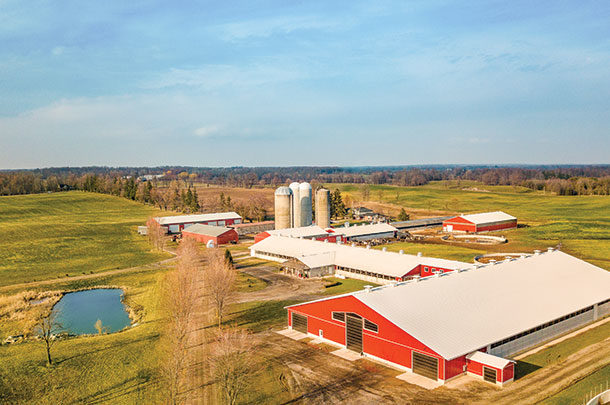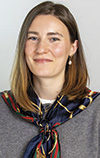Since the farm’s inception in 1958, Bosdale Farms has expanded to accommodate their large family, added a farrow-to-finish commercial pork operation and converted their herd from Ayrshires to Red Holsteins to the purebred Holsteins they have come to be known for.
In August 2020, the Cambridge, Ontario, farm expanded once again with the opening of a new freestall robot barn, connected to their still- operational tiestall barn. The new facility houses 125 milking cows, milked on three DeLaval VMS V310 robotic milkers, with the capacity to expand with an additional 55 milking cows.
“We arrived at the point where we needed more room in the dairy barn to expand because we could no longer fill our quota with the size of operation we were, so we had to come to the decision of how we were going to expand. We decided to attach a modern robot facility to our tiestall [barn], and when we were building, we focused on functionality, cow comfort and cost – but also to make the whole project run smoothly between the two roofs,” says Josh Bos.
To ensure cow comfort, the Bos family implemented wide scrape alleys and crossovers, as well as sand bedding and good ventilation, choosing high-speed fans equipped with misters.
Choosing a robotic milking system over a parlour made the most sense for Bosdale Farms, Josh says. Prior to their recent expansion, the farm was operating their 150-stall tiestall barn at capacity, and expanding the facility would have been too labour-intensive. A robot freestall barn allowed for a smaller facility to be built, compared with the footprint of a parlour facility that could house the same number of cows, as a holding pen was not required. Thus, it could be more easily connected to the farm’s existing facilities, increasing daily milkings without increasing labour requirements.
 In adjusting to their robotic milking system, Bosdale Farms has had to be more vigilant in monitoring the ration they feed to keep their cows from acting sluggish. Photo provided by Josh Bos.
In adjusting to their robotic milking system, Bosdale Farms has had to be more vigilant in monitoring the ration they feed to keep their cows from acting sluggish. Photo provided by Josh Bos.
The farm continues to milk 60 cows in their tiestall barn, with no intentions of changing the setup. “[The tiestall barn] allows us – when things are open – to show off the cows more,” Josh says.
To decide which cows are milked in each barn, the Bos family uses a few different criteria. “At first, we kept fourth-lactation-and-later cows in the tie barn and moved almost everything else to the freestall barn, but now it’s based on adaption and whether or not we want to continue to work with a cow more,” Josh says. He adds they also keep any cows that refuse to use the robot in their tiestall facility and begin all 2-year-old cows on the robot so they can be returned to a robot facility at a later point if necessary.
Now that the new barn has been up and running for over a year, Josh says it brings many advantages. “[We now see] more milk per cow, more cows without the extra labour of a tiestall, improved cow comfort (especially for the younger cows) and higher milk quality with the sand bedding and robots.”
Because of the unique connectivity between the Bos family’s old and new barns, they were also afforded some unique advantages when adjusting to their new facility. “Bosdale Farms was actually a very successful start-up, mainly because the milking facility in their tiestall barn is connected to the robot barn. They were able to have some cows entering the barn ahead of time, and that gets cows used to things,” says Jason French, a VMS solution manager with DeLaval.
 Bosdale Farms chose to expand their facilities, opting to add on a robot freestall barn to their existing tiestall facility due to the smaller footprint it provided over a similar parlour facility. Photo provided by Josh Bos.
Bosdale Farms chose to expand their facilities, opting to add on a robot freestall barn to their existing tiestall facility due to the smaller footprint it provided over a similar parlour facility. Photo provided by Josh Bos. The layout of their new facility can fit 100 more cows than the farm’s tiestall facility – and even when it is fully stocked, Josh predicts it will not require any more labour than before the expansion, when their tiestall facility housed 150 cows.
“With the robot facility, it is a whole different game to manage,” Josh says. “Feed-wise, making sure you’re on top of that ration all the time is very important in the robot barn, more than the tiestall, because to visit the robot, cows have to feel good and be happy, so we don’t want a sluggish cow. Even though [feed issues] may not cause a drop in milk production, they will cause a drop in visits to the robot which, over time, will correlate to decreased production,” he adds.
French says the robots brought changes to the Bos family’s daily routines, creating a bit of a learning curve which was eased by working in combination with the farm and their local dealer to establish a new set of protocols for what an average day would look like. This helped them maximize labour savings and time efficiency.
The robotic milking system has also made some concerns easier to manage, notably the cows’ mammary health. In their robot facility, Josh says the herd’s somatic cell count has hovered around 50,000, and they have treated only two cows for mastitis since their transition.
Because of the data gained from their robotic milking system, the farm has also made some improvements to how they make reproductive decisions. Josh says breeding time and other reproductive decisions in the robot barn are now made exclusively using the data provided by their robotic milking system.
For their efforts to breed pedigreed, high-conforming cow families, including the Portrait Family, Bosdale Farms have been awarded the title of Master Breeder on three occasions. Using A.I., bull proofs and classification, Ed Bos, Josh’s father who leads the farm’s breeding program, says their focus when choosing cows to breed is udder, feet, legs and rumps.
Ed says the one breeding practice he has always emphasized is choosing bulls to meet the farm’s criteria for developing their ideal cow. “I always use the best bulls available. The cheapest money you can invest is buying good semen,” he says.
After more than a year off from showing cows, the Bos family is looking forward to re-entering the show ring and are working to improve their cows for competition. “[We would like to breed cows] that fit more in the show ring. It is in our sights to compete with some of the best in the show ring, but that doesn’t change our breeding philosophy too much. We are still breeding for that high-conformation, long-lasting cow and high production, but are keeping in mind our goal of breeding for show cows as well,” says Josh’s brother Justin Bos.










